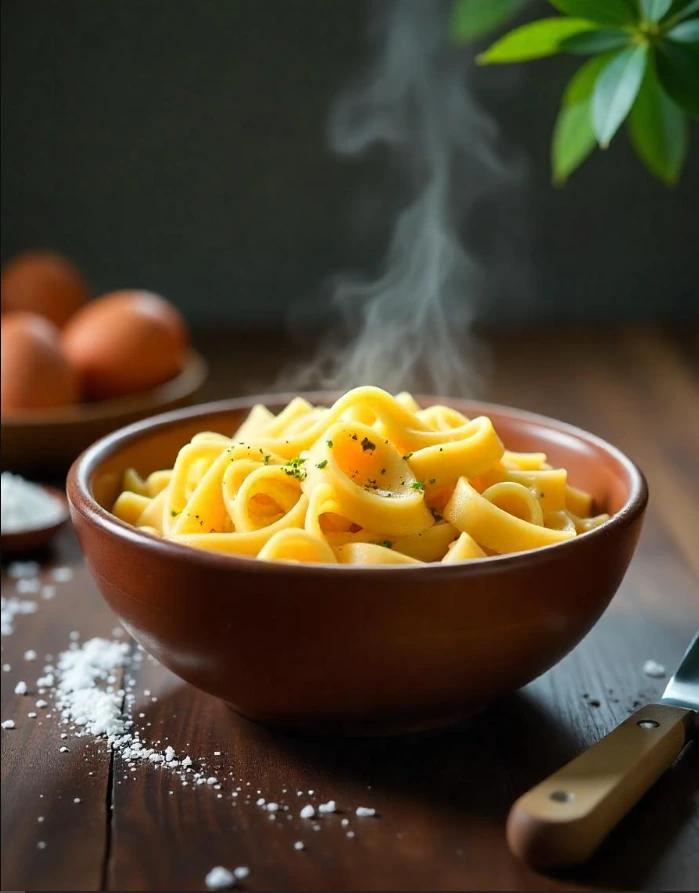Wide egg noodles are a versatile staple in many kitchens, offering a canvas for a wide array of culinary creations. These hearty ribbons of pasta are celebrated not only for their ability to hold bold flavors but also for their adaptability in a variety of cuisines. Whether you’re creating comforting soups, robust casseroles, or quick and easy stir-fries, these noodles provide the perfect foundation for countless dishes.
Their unique texture and composition make them ideal for meals that require a durable base to support rich sauces or intricate flavor combinations. In fact, they are often chosen for their ability to blend seamlessly into dishes without overpowering other ingredients. Moreover, they are equally effective as the star of a meal or as a complement to meats, vegetables, and creamy or tangy sauces.
For those seeking to expand their cooking repertoire, these noodles offer endless possibilities. For example, they can be dressed up with fresh herbs and premium ingredients for a gourmet experience or paired with pantry staples for a quick, satisfying dinner. In addition, they are a go-to option for busy weeknights due to their relatively quick cooking time and ease of preparation.
As you explore the potential of this adaptable ingredient, you’ll discover how it can elevate your cooking. Above all, they offer an opportunity to experiment with flavors and textures, ensuring that each dish you create is uniquely your own. Whether you are recreating traditional recipes or venturing into new culinary territories, these noodles will quickly become an indispensable part of your kitchen.
To delve further into the world of pasta and noodles, visit trusted platforms like Tasty, AllRecipes, and Delish. These resources provide creative ideas and expert tips to help you unlock the full potential of your culinary skills.
What Are Wide Egg Noodles?
Wide egg noodles are pasta-like ribbons made from wheat flour and eggs, giving them a rich, firm texture that distinguishes them from traditional pasta. Because of this, they are perfect for hearty dishes that require noodles to hold their shape and absorb flavors. They are commonly used in a variety of recipes, such as soups, casseroles, and stir-fries, but their versatility extends beyond these classic applications.
In addition, these noodles shine when paired with a wide range of sauces, from creamy and savory to tangy and spicy. For a deeper look into pasta variations, explore our post on Ditalini Pasta, a smaller pasta option that is equally versatile and delicious.
How to Cook Wide Egg Noodles Perfectly
Steps for Boiling Wide Egg Noodles
Cooking wide egg noodles may seem simple, but achieving the perfect texture requires attention to detail. For example, following these steps ensures that your noodles are cooked just right:
- Prepare Your Water: Fill a large pot with water and bring it to a vigorous boil. Add a generous pinch of salt to enhance the noodles’ flavor.
- Add the Noodles: Gently place the noodles into the boiling water, stirring occasionally to prevent them from sticking together.
- Monitor the Cooking Time: Generally, these noodles take 8–10 minutes to reach an al dente texture. Be sure to check the packaging for specific timing.
- Drain and Rinse: Once cooked, drain the noodles in a colander and rinse them briefly with cold water. This stops further cooking and removes excess starch.
- Toss with Oil: To prevent the noodles from clumping, toss them with a small amount of olive oil.
Additionally, pairing these noodles with flavorful broths, like in our Chicken Poblano Soup, enhances their taste and elevates simple dishes into memorable meals.
Pro Tips for the Perfect Noodle Dish
- Use a large pot with ample water—at least 4–6 quarts per pound of noodles—to ensure even cooking.
- Taste-test the noodles during cooking to avoid overcooking and achieving the ideal texture.
- Save some of the cooking water to enhance your sauce. In fact, adding pasta water to sauces creates a silky texture and adds flavor.
Creative Recipes Using Wide Egg Noodles
Classic Chicken Noodle Soup
Chicken noodle soup is a timeless favorite, and wide egg noodles are a key ingredient in making it hearty and satisfying. The rich, comforting broth complements the firm texture of the noodles perfectly. Moreover, adding fresh vegetables like carrots and celery brings additional depth and nutritional value to the dish.
Creamy Beef Stroganoff
This classic dish is a perfect match for wide egg noodles, as their sturdy texture holds up beautifully under the creamy, savory sauce. For example, the combination of beef strips, mushrooms, and sour cream creates a luscious and indulgent meal.
- Ingredients: Beef strips, mushrooms, sour cream, garlic, onions, and wide egg noodles.
- Steps: Sauté beef and mushrooms, prepare a creamy sauce with sour cream, and toss with cooked noodles.
- In addition, for a lighter version, substitute beef with chicken or tofu for a fresh twist.
Asian-Inspired Stir-Fried Noodles
Wide egg noodles are also an excellent choice for stir-fries. Toss them with soy sauce, sesame oil, and fresh vegetables for a quick and flavorful meal. Similarly, you can add hoisin or oyster sauce to introduce a depth of flavor.
For instance, if you’re seeking bold and unique noodle dishes, explore our Birria Ramen, which combines Asian and Mexican influences for a distinctive culinary experience.
Tips for Enhancing the Flavor of Wide Egg Noodles
Pairing with Vegetables
Wide egg noodles pair beautifully with roasted or sautéed vegetables like zucchini, bell peppers, or broccoli. For example, these vegetables add texture and color, making your dish more visually appealing and nutritious. In addition, these noodles are a fantastic base for casseroles. Layer them with cheese, meats, and béchamel sauce for a filling, crowd-pleasing meal, like in our Passover Potato Pie.
Frequently Asked Questions
- How long should they cook? Wide egg noodles typically take 8–10 minutes to cook, but always check the package instructions.
- Can they be used in salads? Yes, they are excellent in cold pasta salads with fresh vegetables and vinaigrette.
- What’s the best way to store leftovers? Store cooked noodles in an airtight container in the refrigerator for up to 5 days.
Nutritional Benefits and Cooking Tips for Egg-Based Noodles
Egg-based noodles are not just a versatile cooking ingredient; they also offer notable nutritional benefits. For instance, they contain protein from the eggs, making them more nutrient-dense compared to some traditional pasta options. Additionally, their rich composition provides energy, making them an excellent choice for filling, satisfying meals.
Simple Tips to Get the Most Out of Your Cooking
When preparing these noodles, a few key techniques can ensure the best results:
- Salt the Water Generously: Adding salt to boiling water enhances the flavor of the noodles before you even add sauce.
- Avoid Overcooking: To maintain their firm texture, cook them until just al dente and rinse with cold water to stop the cooking process.
- Experiment with Pairings: Pair these noodles with fresh herbs, roasted vegetables, or lean proteins like chicken or shrimp for a balanced and flavorful meal.
Moreover, storing leftovers is easy—simply toss cooked noodles with a bit of olive oil to prevent sticking and keep them in an airtight container in the refrigerator for up to three days. Reheat with a splash of water or broth to revive their original texture.
Creative Serving Ideas
Egg-based noodles can be the star of the dish or a complementary side. For example, mix them with pesto and roasted cherry tomatoes for a light, refreshing meal, or use them as a base for stroganoff or chicken marsala. In contrast, they also work well in baked casseroles with layers of cheese, meat, and sauce, offering hearty options for family dinners.
Versatility in Global Cuisines
Egg-based noodles are a cornerstone in many global cuisines, prized for their ability to adapt to a variety of cooking styles and flavor profiles. For example, in European dishes, they are often paired with creamy sauces like Alfredo or used in baked casseroles layered with cheese and vegetables. On the other hand, in Asian cuisines, they shine in stir-fries, soups, and noodle bowls flavored with soy sauce, sesame oil, and spices.
Regional Variations
In addition, these noodles serve as a bridge between traditional recipes and modern culinary trends:
- Italian Influence: Used in rich, cheesy casseroles or paired with tomato-based sauces for a hearty meal.
- Asian Inspiration: Stir-fried with fresh vegetables and protein or served in brothy soups with a hint of ginger and garlic.
- American Comfort Foods: Frequently featured in classic chicken noodle soup or creamy beef stroganoff.
Pairing with Proteins and Vegetables
One of the reasons these noodles are so popular is their ability to complement almost any protein or vegetable. For instance, pair them with tender slices of chicken, savory beef, or even seafood for a protein-rich dish. Similarly, roasted vegetables like zucchini, broccoli, or bell peppers enhance the dish’s flavor and provide a pop of color.
Moreover, these noodles can be used in vegetarian dishes, creating hearty meals that rely on mushrooms, spinach, or lentils for flavor and texture. Their versatility makes them a staple ingredient for both simple weeknight dinners and elaborate weekend feasts.
Creative Recipe Ideas
- Asian Stir-Fry Bowl: Combine noodles with teriyaki sauce, mixed vegetables, and grilled tofu or chicken for a quick and healthy dinner.
- Creamy Mushroom Casserole: Layer noodles with a creamy mushroom sauce and top with breadcrumbs for a comforting baked dish.
- Cold Noodle Salad: Toss cooked noodles with a sesame dressing, cucumber, and shredded carrots for a refreshing summer meal.
Conclusion
Wide egg noodles are a versatile and flavorful ingredient that can be used in countless recipes, from classic soups to innovative stir-fries and casseroles. Their unique texture and ability to blend seamlessly with a variety of flavors make them an essential pantry staple. As a result, mastering the art of cooking and pairing wide egg noodles will open up endless opportunities for culinary exploration.
In conclusion, for more recipe inspiration and tips, visit trusted platforms like Tasty, AllRecipes, and Delish. Finally, these resources offer valuable ideas and creative techniques to inspire your next culinary adventure.

